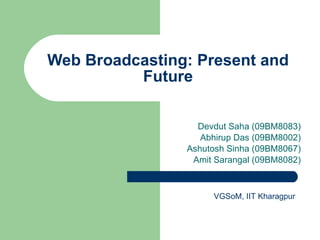Mis presentation -quest
- 1. Web Broadcasting: Present and Future Devdut Saha (09BM8083) Abhirup Das (09BM8002) Ashutosh Sinha (09BM8067) Amit Sarangal (09BM8082) VGSoM, IIT Kharagpur
- 2. Web broadcasting Live streamingâ content is lost after broadcast is over Online video/audio/multimedia sharing â can access the content at any point of time
- 5. Tools and services in Broadcasting Live broadcasting Scheduled broadcasting On-demand broadcasting Embed live video/recorded video Integrated text/video chat Webcam/mobile capture Images Music Add titles Multiple participants Import video
- 6. Comparison of different players
- 8. Change in the concept (Web 2.0) Old concept â One way communication of media. No dialogue or way of taking part in the production of the content. New concept â Two way collaborative content and media production and consumption. Audience actively takes part in the creation of the media. Feeling of commitment. Sharing and interacting in real time.
- 9. Video on demand Allows users to select and watch video content on demand depending upon his convenience of time. Provide the user with a large subset of functionality including pause , fast forward , fast rewind , slow forward, jump to previous/future frame etc
- 10. Video hosting A video hosting service  allows individuals to upload video clips on internet website. The video host will then store the video on its server, and show the individual different types of code to allow others to view this video. The website, mainly used as the video hosting website , is usually called the video sharing website
- 11. Why Youtube didnât existed earlier? Streaming server costs were very high say 10 years back Number of internet users were very limited Internet was not considered as a primary means of communication Userâs bandwidth was very less as compared to todayâs bandwidth
- 12. Purpose of video hosts (for users) Save on bandwidth  costs, often eliminating costs entirely Creating a common place Make a hassle-free experience, where uploading  a video and streaming  or embedding  would normally require advanced programming knowledge. It is now commonly achieved through a web browser , with little or no programming experience.
- 13. Business models for video on demand For free services the main source of revenue is by advertising on the site for ex Youtube For satellite channels , the main source of revenues comes from subscriptions and advertising mainly
- 14. Advertising Video on demand sites have advertisements flashing on the homepage along with the video There are different subscriptions rates depending upon the number of ads as well as the duration of the ads on youtube
- 15. Example
- 16. Why people advertise on Youtube? Youtube is currently the 2 nd most visited site in the world right behind google It means that there are millions of people visiting Youtube everyday and the scope of reaching them is huge....
- 17. Ways to advertise on Youtube Through google Self-Managed Advertising (AdWords) Managed Accounts Through youtube Self-Managed Advertising (Promoted Videos) YouTube Direct Ad Sales
- 18. Competition base Users visiting the sites The content available on the site
- 19. Potential threats Copyright/piracy issue Upload of inappropriate contents Advertiserâs bargaining power â many sites are available (Youtube, metacafe etc.) Various audio/video/image formats to support (e.g. metacafe doesnât support .asf )
- 20. Latest in video hosting (on demand to live streaming) A mobile live streaming software called QIK allows the users to upload videos from their cell phones to the internet. The videos will then be stored online and can be shared to various social networking sites like Twitter, Facebook and YouTube. Videos will be stored on the servers and can be watched from both the mobile devices and the website.
- 21. Bambuser Stream live video from mobile/webcam using 3G /WiFi network Interact and communicate through web to mobile chat Geo tagging enabled via cell-id or GPS
- 22. Advantage of Bambuser over Qik Lower latency due to superior technical approaches Streaming both from computer and mobile Stream videos from mobile to Facebook wall
- 23. How it works Install the application on your mobile and use instead of your normal video capturing tool The application uses the networks (EDGE, GPRS, 3G or WiFi) to transmit the video data from bambuser servers to the web Needs operating systems like windows, Symbian S60, Mac OSx.
- 24. Challenge and approach Challenge â poor mobile network Approach â transmit as much as data possible and simply skip the data that canât get through the networks and save it for later. Data dropped during broadcast is uploaded afterwards the video is completed and is provided on demand.
- 25. Business Model
- 26. Business Model Free services Premium services like ad-administration system, support, editing functions, dedicated bandwidth, extensive management tools
- 27. Potential threats Television is a substitute to IPTv Technology advancements Dependency on mobile devices (high end sets) Competition on latency http://vimeo.com/3332611
- 28. The future Technology is getting advanced and cheaper Growth rate is 99% for broadcasting More and more people will be using internet and high end mobile devices and technology
- 29. Thank You




























